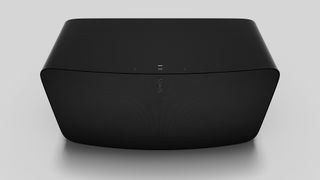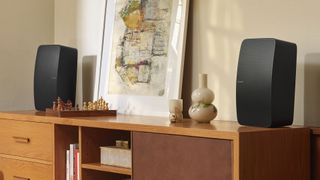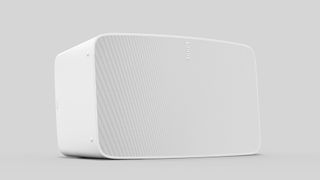Sonos Five review: a wireless speaker with real room-filling sound
The Sonos Five delivers the scale and bass to really satisfy music lovers


The Sonos Five provides astonishingly room-filling, detailed and warm sound as well as potential software updates down the line thanks to advanced internal specs. It may be only a subtle refresh of the old Play:5, but perhaps Sonos can afford to rest on its laurels with this excellent streaming speaker.
-
+
Warm, clear and entertaining sound
-
+
Wide dispersion of audio
-
+
Flexible use options
-
+
Future-proofed
-
-
No microphone for voice control
-
-
No Bluetooth
-
-
No hi-res support yet
Why you can trust T3
If necessity is the mother of invention, then it should come as no surprise that the latest version of the Sonos Five all-in-one wireless streaming speaker looks and sounds remarkably like the model it’s meant to replace. This absence of reinvention is understandable when you consider that, quite frankly, very little in the way of upgrading was needed.
Its forerunner, the Sonos Play:5 Gen 2, has been wildly successful since its release in 2015, offering a simple, curvy monochrome design, precise, robust and adaptable sound and well-integrated streaming smarts. After attaining near-universal acclaim and with future compatibility assured, there just wasn’t much need for Sonos to overhaul a product that already performs incredibly well. So what has Sonos actually changed with the Sonos Five, and is it worth upgrading to?
The new Sonos Five may have dropped the ‘Play’, but thankfully it has retained all the features that made its predecessor so popular, including a line-in that can be used to add an external source and versatile positioning for stereo pairing with a second speaker. It has, however, also undergone the most subtle of makeovers both externally and internally, which, while they may seem inconsequential now, will likely pay some dividends in the future.
The end result is an excellent-sounding box that's absolutely one of the best wireless speakers available today.
Sonos Five review: Price & release date
The Sonos Five was released in June 2020, and is priced at £499/$549/AU$799 for a single unit – you don't tend to see a lot of discounts on Sonos products, so you're likely to have to pay asking price, or close to it.
The Sonos Five is pricey compared to newer competitors in the multi-room wireless speaker market, such as the Audio Pro Addon C10 MKII – though is significantly less than the likes of the B&W Zeppelin or B&O Beosound Level.
If you’re planning to pair it with a second Sonos Five, the cost starts getting into the realms of the KEF LSX, which, unlike the Sonos Five, has a more comprehensive connectivity spec, existing hi-res capabilities and greater choice of colours. So it walks a fine line – we'd say it's good value, but depending on your needs, there may an option that uses your money better.

Sonos Five review: Features & what's new
The tiny rubber feet on three sides of the Sonos Five are easy to miss, but cunningly, they mean it can be placed vertically or horizontally. A single Sonos Five positioned on its long side will deliver sound in stereo. However, when synced with a second speaker (only another identical model, not an original Sonos Play:5, sadly), each individual speaker will switch to mono for a more traditional stereo pair configuration, or you can use them as rear surrounds in a home cinema set-up with a Sonos Arc. In these cases, you can use them upright instead.
At the rear are three sockets for power, ethernet and a mini-jack input to add a source, such as a record player, which can then also be streamed throughout your entire Sonos network.
Under the grille, the internal speaker arrangement is identical to the Play:5, with six class D amplifiers driving three 10cm mid-woofers across the bottom and three tweeters on the top, two of which are angled for broader dispersion.
But despite all the surface things that have stayed the same, there have been changes made to the internal technology, including increased memory and a more powerful Quad-core 1.4 GHz CPU processor. Users may notice that this makes controlling the speaker a bit quicker, but it also indicates that this model is one that Sonos is future-proofing for potential firmware upgrades down the line that could include the long-rumoured addition of hi-res music support.
The Sonos Five also features inbuilt BLE (Bluetooth Low Energy) and NFC (Near Field Communication) compatibility to make the initial set-up process more seamless. In another subtle tweak to the internal architecture, the speaker can now maintain a more stable and powerful Wi-Fi connection.
While you can directly stream music and radio from the S2 app, Spotify Connect or Apple AirPlay 2, there is no Bluetooth streaming onboard, which may put some users off – but as this is a product designed to stay in situ on a wireless network, it’s not a great loss.
However, a more significant omission is the lack of voice control support that many of its smart speaker competitors offer, such as the Amazon Echo Studio. The Sonos Five doesn’t contain any in-built microphones, but will work with Alexa and Google Home if you already have a control device on your home network. You just can't actually as the Sonos Five itself to do something for you.
But Sonos’ excellent app and ease of use as part of the company’s wider ecosystem mean that for users already committed to the brand or those looking to build a reliable multi-room set-up, it’s still an attractive choice if not currently the most competitive one.

Sonos Five review: Sound quality
Many companies claim that they produce a single speaker that can fill a room, but the Sonos Five really delivers in this respect. Used alone in its horizontal position, the dispersion is extensive and consistently detailed, making it great to listen to even in awkward spaces like kitchens and bathrooms (fortunately, the Sonos Five is humidity resistant, though you still might want to focus on the more waterproof Sonos Move or Sonos Roam for your wetroom).
We recommend using the Truplay room calibration software found on the S2 app, especially if placing the speaker in a corner or a room full of hard surfaces. Truplay uses the microphone on your phone to optimise the sound speaker to your space, with the process taking only a few minutes and the resulting adjustments easy to toggle on and off.
Considering the compact size of the cabinet, the Sonos Five’s low end is impressively punchy and distinct, particularly at higher volumes, and there’s excellent sonic separation across the board. Bass and kick are neatly defined while other instrument arrangemens and vocals are well projected and clear but full of tonal subtly.
Only when pushed to the extremes does it feel like the Sonos Five has to keep the bass at arm’s length, where it will still be tightly controlled, but somewhat flat. The low end occasionally feels slightly overemphasised when listening at background levels, although the in-app EQ settings make it easy to adjust for taste.
It’s the warmth of the mid-range and treble, though, that is the most striking feature of this compact system. Songs deliver gentle richness even when sparse and rough, while more distorted fare retains its melodic ease and coherence at both low and high volumes.
The timing and responsiveness of the Sonos Five shows itself in swift transients and impeccable dynamics of things like drums. Occasionally we find it lacking a touch of top-end sparkle, but the voicing that Sonos has chosen manages to retain transparency without verging harshness across a range of volumes and musical styles.

Sonos Five review: Design & usability
The Sonos Five has the same bulging convex cabinet as the Play:5, only now it sports a grille precisely colour matched to the main body and a more muted version of the company’s palindromic logo. This minor tweak gives the overall appearance a more refined, discreet and modern look that’s in keeping with the rest of Sonos’ recent releases.
Across the top edge (or side depending on how you position it) are three touch-sensitive buttons for easy access to basic volume and skip functions, but this being a Sonos product, you’ll primarily be using the company’s flawless app to control playback. It’s worth noting that the Sonos Five is only compatible with S2, the newest version of the app, so if you have any legacy products that operate on S1, then you won’t be able to integrate the new speaker into your existing setup.
The app makes it easy to connect with music services and then start playing – and for Apple users, AirPlay 2 support works perfectly, making it easy to play anything from any app.
Sonos Five review: Verdict
As you’d expect from Sonos, the Five is a classy speaker that can deliver audio in a manner that is both well-pervading for background music and sonically sophisticated enough for more concentrated listening.
If you already have a Play:5 and are considering an upgrade, it may be worth holding off for now as the Sonos Five doesn’t offer much more in the way of features or functionality just yet – though if your Play:5 is holding you back from being able to upgrade to the S2 app, then the Sonos Five is certainly a worthy successor.
But for users already invested in the Sonos ecosystem or those looking for a future-proofed streaming solution, it’s a hassle-free and sonically powerful option.
Sonos Five review: Also consider
The Naim Mu-so Qb (2nd Gen) and B&W Zeppelin are the two big competitors if you're looking for maximum audio quality, and would consider spending more. The Naim is actually smaller than the Sonos Five, and is packed with high-end audio gear and angle speaker drivers. It's superb. The Zeppelin is a wide beast with a design that stands out, but again features top-tier technology from a hi-fi great.
Sign up to the T3 newsletter for smarter living straight to your inbox
Get all the latest news, reviews, deals and buying guides on gorgeous tech, home and active products from the T3 experts
Mary is an audio expert, with over a decade of experience as a sound engineer, working on live events, theatre and music. She's currently a staff writer at What Hi-Fi?, casting her ear over the world's latest and greatest ways to generate pleasant noise.
-
 This smart tracking device has something Apple's AirTag can't match – and it's very affordable too
This smart tracking device has something Apple's AirTag can't match – and it's very affordable tooKickstarter project could shake up the Find My market
By Britta O'Boyle Published
-
 Nvidia Shield TV gets its biggest free experience update in years
Nvidia Shield TV gets its biggest free experience update in yearsNvidia continues to support its Android TV streaming box, which is still one of the best around
By Rik Henderson Published
-
 Build muscle and burn fat with just two kettlebells and this 20 minute workout
Build muscle and burn fat with just two kettlebells and this 20 minute workoutDon't have long to train? A fitness coach says this workout delivers plenty of bang for your buck
By Bryony Firth-Bernard Published